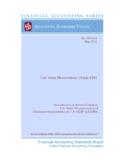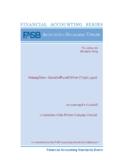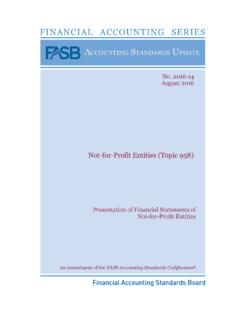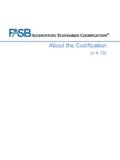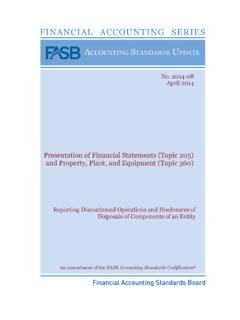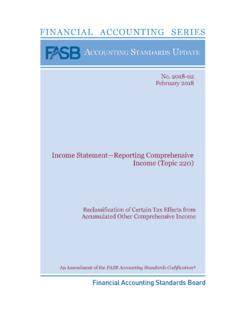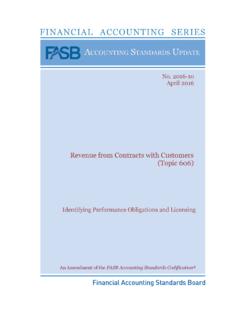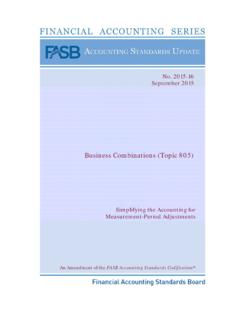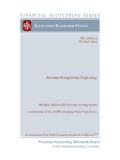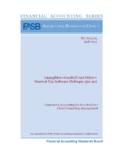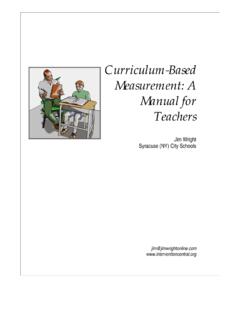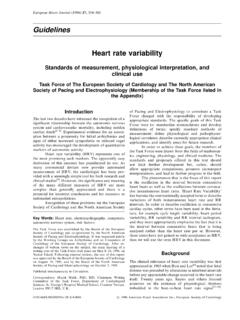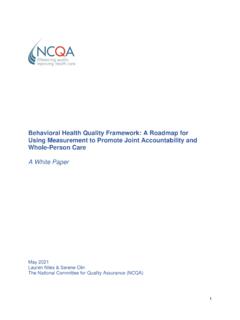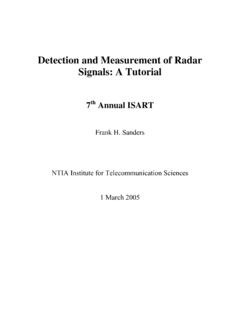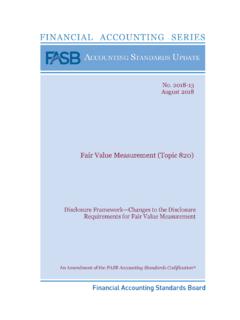Transcription of Fair Value Measurement (Topic 820) Disclosures for ...
1 Fair Value Measurement (Topic 820) No. 2015-07 May 2015 Disclosures for Investments in Certain Entities That Calculate Net Asset Value per Share (or Its Equivalent) a consensus of the FASB Emerging Issues Task Force An Amendment of the FASB Accounting Standards Codification The FASB Accounting Standards Codification is the source of authoritative generally accepted accounting principles (GAAP) recognized by the FASB to be applied by nongovernmental entities. An Accounting Standards Update is not authoritative; rather, it is a document that communicates how the Accounting Standards Codification is being amended.
2 It also provides other information to help a user of GAAP understand how and why GAAP is changing and when the changes will be effective. For additional copies of this Accounting Standards Update and information on applicable prices and discount rates contact: Order Department Financial Accounting Standards Board 401 Merritt 7 PO Box 5116 Norwalk, CT 06856-5116 Please ask for our Product Code No. ASU2015-07. FINANCIAL ACCOUNTING SERIES (ISSN 0885-9051) is published quarterly by the Financial Accounting Foundation.
3 Periodicals postage paid at Norwalk, CT and at additional mailing offices. The full subscription rate is $242 per year. POSTMASTER: Send address changes to Financial Accounting Standards Board, 401 Merritt 7, PO Box 5116, Norwalk, CT 06856-5116. | No. 414 Copyright 2015 by Financial Accounting Foundation. All rights reserved. Content copyrighted by Financial Accounting Foundation may not be reproduced, stored in a retrieval system, or transmitted, in any form or by any means, electronic, mechanical, photocopying, recording, or otherwise, without the prior written permission of the Financial Accounting Foundation.
4 Financial Accounting Foundation claims no copyright in any portion hereof that constitutes a work of the United States Government. An Amendment of the FASB Accounting Standards Codification No. 2015-07 May 2015 Fair Value Measurement (Topic 820) Disclosures for Investments in Certain Entities That Calculate Net Asset Value per Share (or Its Equivalent) Accounting Standards UpdateFinancial Accounting Standards Board Accounting Standards Update 2015-07 Fair Value Measurement (Topic 820) Disclosures for Investments in Certain Entities That Calculate Net Asset Value per Share (or Its Equivalent) May 2015 CONTENTS Page Numbers Summary.
5 1 3 Amendments to the FASB Accounting Standards Codification .. 5 22 Background Information and Basis for Conclusions .. 23 28 Amendments to the XBRL Taxonomy .. 29 1 Summary Why Is the FASB Issuing This Accounting Standards Update (Update)? Topic 820, Fair Value Measurement , permits a reporting entity, as a practical expedient, to measure the fair Value of certain investments using the net asset Value per share of the investment. Currently, investments valued using the practical expedient are categorized within the fair Value hierarchy on the basis of whether the investment is redeemable with the investee at net asset Value on the Measurement date, never redeemable with the investee at net asset Value , or redeemable with the investee at net asset Value at a future date.
6 For investments that are redeemable with the investee at a future date, a reporting entity must take into account the length of time until those investments become redeemable to determine the classification within the fair Value hierarchy. There is diversity in practice related to how certain investments measured at net asset Value with redemption dates in the future (including periodic redemption dates) are categorized within the fair Value hierarchy. The objective of this Update is to address that diversity in practice. Who Is Affected by the Amendments in This Update?
7 The amendments in this Update apply to reporting entities that elect to measure the fair Value of an investment within the scope of paragraphs 820-10-15-4 through 15-5 using the net asset Value per share (or its equivalent) practical expedient in paragraph 820-10-35-59. What Are the Main Provisions? The amendments in this Update remove the requirement to categorize within the fair Value hierarchy all investments for which fair Value is measured using the net asset Value per share practical expedient. The amendments also remove the requirement to make certain Disclosures for all investments that are eligible to be measured at fair Value using the net asset Value per share practical expedient.
8 Rather, those Disclosures are limited to investments for which the entity has elected to measure the fair Value using that practical expedient. 2 How Do the Main Provisions Differ from Current Generally Accepted Accounting Principles (GAAP) and Why Are They an Improvement? Current GAAP requires that investments for which fair Value is measured at net asset Value (or its equivalent) using the practical expedient in Topic 820 be categorized within the fair Value hierarchy using criteria that differ from the criteria used to categorize other fair Value measurements within the hierarchy.
9 Under the amendments in this Update, investments for which fair Value is measured at net asset Value per share (or its equivalent) using the practical expedient should not be categorized in the fair Value hierarchy. Removing those investments from the fair Value hierarchy not only eliminates the diversity in practice resulting from the way in which investments measured at net asset Value per share (or its equivalent) with future redemption dates are classified, but also ensures that all investments categorized in the fair Value hierarchy are classified using a consistent approach.
10 Investments that calculate net asset Value per share (or its equivalent), but for which the practical expedient is not applied will continue to be included in the fair Value hierarchy. A reporting entity should continue to disclose information on investments for which fair Value is measured at net asset Value (or its equivalent) as a practical expedient to help users understand the nature and risks of the investments and whether the investments, if sold, are probable of being sold at amounts different from net asset Value . When Will the Amendments Be Effective?
